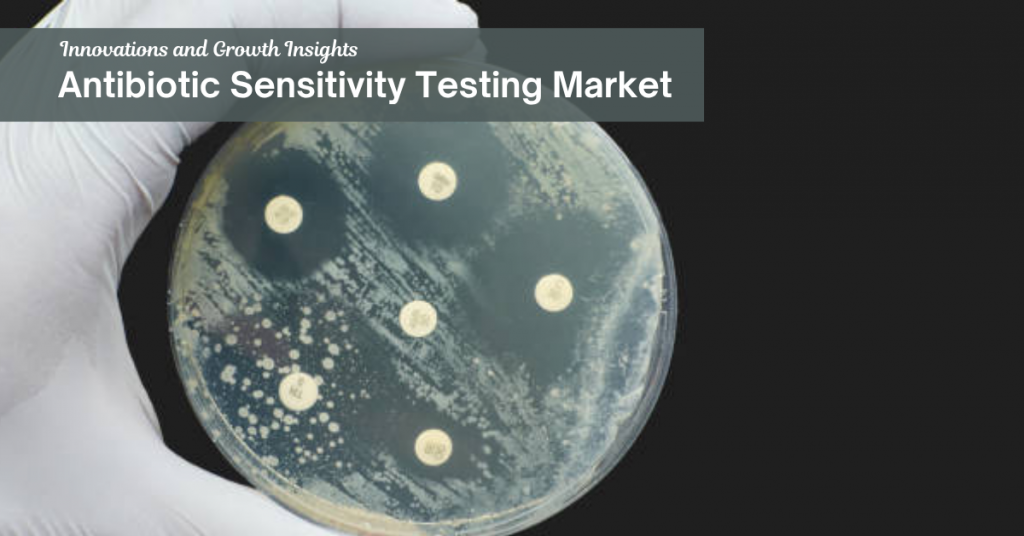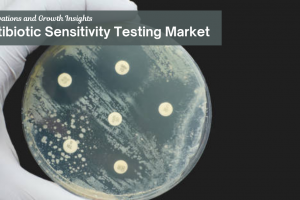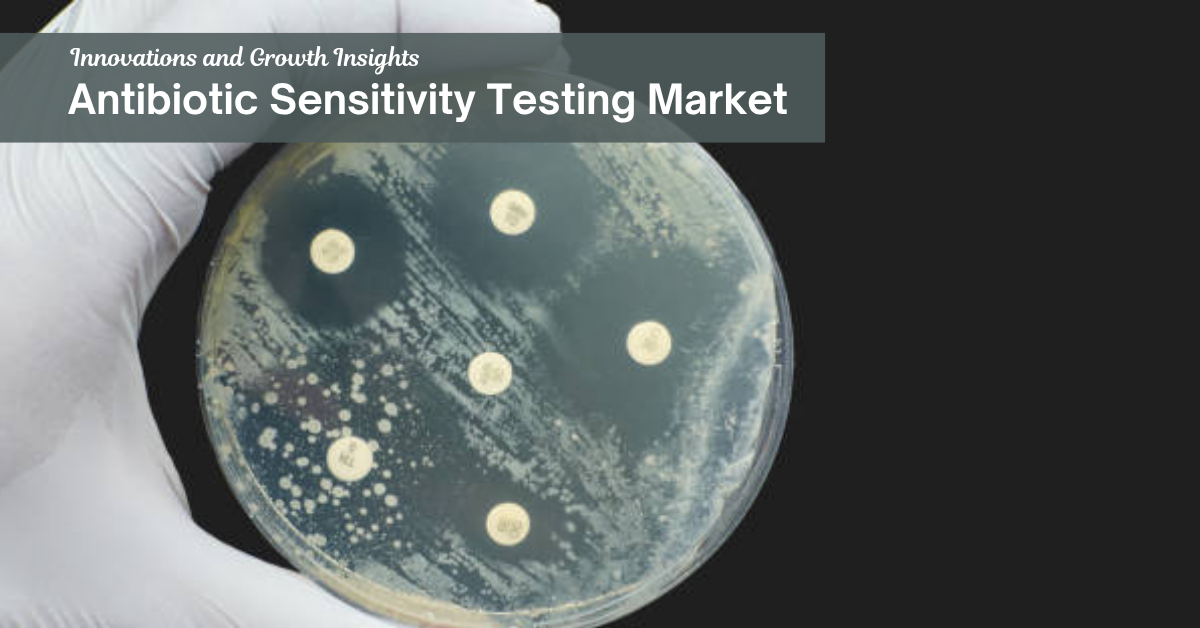
Market Overview
The antibiotic sensitivity testing market is poised for substantial growth, anticipated to rise from USD 1,950 million in 2024 to approximately USD 2,859 million by 2032. This represents a steady compound annual growth rate (CAGR) of 4.9%.
This market expansion reflects the critical role antibiotic sensitivity testing plays in modern healthcare by enabling the precise identification of bacterial susceptibilities to antibiotics. The growing burden of antimicrobial resistance has emphasized the necessity of such diagnostic tools to guide effective treatment protocols. As healthcare systems worldwide face the challenge of resistant infections, the ability to accurately detect sensitivity profiles ensures improved patient outcomes, reduced hospital stays, and lower healthcare costs. Moreover, the increasing adoption of automated and rapid testing technologies further enhances the market’s relevance by shortening diagnosis times and supporting antimicrobial stewardship programs globally.
Additionally, the rise of drug-resistant bacterial strains and global initiatives to combat antimicrobial resistance contribute to sustained demand. With governments and private players investing in diagnostic infrastructure and R&D, the antibiotic sensitivity testing market stands at the forefront of medical innovation. This growth trajectory aligns with the ongoing need to address public health challenges and improve clinical decision-making worldwide.
Get full details: https://www.credenceresearch.com/report/antibiotic-sensitivity-testing-market
Market Drivers
Increasing Prevalence of Infectious Diseases: The rising incidence of bacterial infections, particularly in hospital and community settings, is a key driver of the antibiotic sensitivity testing market. Frequent outbreaks of drug-resistant infections require routine testing to determine the most effective antibiotic therapy, fueling demand for robust sensitivity testing solutions. This trend is particularly prominent in intensive care units and long-term care facilities where vulnerable populations reside.
Advancements in Diagnostic Methodologies: Significant improvements in diagnostic techniques, including the introduction of next-generation sequencing and molecular-based assays, are reshaping the market landscape. These technologies offer faster and more comprehensive resistance profiling compared to conventional culture methods. Enhanced sensitivity and specificity contribute to more reliable clinical decision-making and better antimicrobial use.
Expanding Healthcare Infrastructure in Developing Regions: Investments in healthcare infrastructure, especially in Asia-Pacific and Latin America, are expanding access to diagnostic services. Growing government initiatives to improve infectious disease control are supporting the establishment of diagnostic laboratories equipped with modern sensitivity testing technologies. This expansion provides untapped opportunities for market players.
Increased Focus on Antimicrobial Stewardship: The global emphasis on reducing antibiotic misuse has led to the widespread implementation of stewardship programs that rely heavily on sensitivity testing. These initiatives aim to optimize antibiotic prescribing practices by providing real-time data on pathogen susceptibilities. Consequently, healthcare providers are increasingly adopting antibiotic sensitivity testing to align with best practice guidelines and reduce resistance spread.
Market Challenges
Limited Accessibility in Low-Income Regions: Despite growing demand, limited access to quality diagnostic facilities in economically disadvantaged regions restricts market growth. Infrastructure deficits and scarcity of trained personnel hamper effective implementation of sensitivity testing, impeding efforts to manage antibiotic resistance locally.
Fragmented Regulatory Landscape: Diverse and sometimes inconsistent regulatory standards across different countries complicate the introduction of new testing products. This fragmentation leads to prolonged approval timelines and increased costs for manufacturers, reducing the speed at which innovative solutions reach markets globally.
Technical Complexity and Skill Requirements: The operation of sophisticated automated testing equipment requires specialized training, which is often lacking in resource-constrained settings. This skill gap limits the deployment of advanced testing platforms and impacts the quality and reliability of test results.
Competition from Alternative Diagnostic Methods: Emerging rapid diagnostic technologies, such as molecular assays and biosensors, offer alternative approaches to antibiotic susceptibility testing. These novel methods may compete with traditional culture-based tests, creating uncertainty regarding long-term market dynamics.
Market Opportunity
Rising Demand for Rapid Testing: There is a growing need for faster antibiotic susceptibility results to enable prompt clinical decisions, particularly in emergency and critical care settings. Development of rapid testing kits and point-of-care devices presents significant growth opportunities for market players.
Expansion of Personalized Treatment Models: Increasing adoption of precision medicine encourages the use of sensitivity testing to tailor antibiotic therapies. Customized treatment plans based on individual pathogen profiles improve therapeutic effectiveness and reduce adverse effects, driving demand for advanced diagnostic services.
Growth of Pharmaceutical R&D: Antibiotic sensitivity testing is an integral component of drug development pipelines. As pharmaceutical companies focus on discovering novel antibiotics and combating resistance, their reliance on accurate susceptibility data will spur market growth in this segment.
Integration with Health IT Systems: The integration of sensitivity testing data with electronic health records (EHR) and clinical decision support systems offers opportunities to enhance antimicrobial stewardship and patient management. This digital transformation facilitates data sharing and analysis, improving overall healthcare delivery.
Market Segmentation
Based on Product Type
- Manual Testing
- Automated Testing
- Consumables
Based on Application
- Clinical Diagnostics
- Drug Discovery and Development
- Epidemiology
- Others
Based on End-User
- Hospitals
- Diagnostic Laboratories
- Pharmaceutical and Biotechnology Companies
- Research and Academic Institutes
Based on the Geography:
North America
- U.S.
- Canada
- Mexico
Europe
- UK
- France
- Germany
- Italy
- Spain
- Russia
- Belgium
- Netherlands
- Austria
- Sweden
- Poland
- Denmark
- Switzerland
- Rest of Europe
Asia Pacific
- China
- Japan
- South Korea
- India
- Australia
- Thailand
- Indonesia
- Vietnam
- Malaysia
- Philippines
- Taiwan
- Rest of Asia Pacific
Latin America
- Brazil
- Argentina
- Peru
- Chile
- Colombia
- Rest of Latin America
Middle East & Africa
- GCC Countries
- South Africa
- Rest of the Middle East and Africa
Regional Analysis
North America dominates the antibiotic sensitivity testing market, driven by cutting-edge healthcare infrastructure, high adoption rates of advanced testing methods, and extensive research activities. The U.S. leads with significant investments in diagnostics and antimicrobial resistance initiatives. Canada and Mexico contribute through expanding healthcare access and increased public health focus.
Europe holds a substantial share, with countries like Germany, the UK, and France spearheading demand due to strong pharmaceutical sectors and comprehensive regulatory frameworks. The European Union’s collective efforts toward antimicrobial stewardship and standardized testing protocols enhance market stability and growth prospects.
Asia Pacific is the fastest-growing market, propelled by rapid urbanization, rising infectious disease burden, and government-backed healthcare expansions. China, India, and Japan are key contributors, investing heavily in diagnostic innovation despite regional disparities in healthcare accessibility. Increasing awareness and healthcare spending fuel this robust growth.
Latin America shows steady growth driven by rising healthcare expenditure and the implementation of antibiotic resistance containment strategies. Brazil and Argentina lead the market, bolstered by investments in laboratory infrastructure and public health programs.
The Middle East & Africa is an emerging market segment, with gradual improvements in healthcare facilities and growing awareness of antimicrobial resistance. GCC countries and South Africa are pivotal in adopting new testing technologies, supported by regional healthcare modernization efforts and international collaborations.
Top Companies
- Bio-Rad Laboratories, Inc.
- Danaher Corporation
- Liolchem S.r.l.
- HiMedia Laboratories
- Accelerate Diagnostics, Inc.
- Becton, Dickinson and Company
- Thermo Fisher Scientific Inc.
- Alifax S.r.l.
- Merck KGaA
- Creative Diagnostics
Future Outlook
- The market is anticipated to witness increased adoption of rapid and automated testing platforms worldwide.
- Technological innovations, including AI integration, will enhance diagnostic accuracy and speed.
- Expansion in emerging economies will continue due to rising healthcare investments and infectious disease prevalence.
- Point-of-care testing devices will become more widespread, enabling on-site antibiotic susceptibility assessments.
- Partnerships between diagnostics firms and pharmaceutical companies will foster innovation in resistance detection.
- Multiplex and molecular testing technologies will gain prominence for comprehensive pathogen profiling.
- Personalized medicine trends will further drive demand for tailored antibiotic sensitivity testing.
- Digital health and data analytics integration will optimize antimicrobial stewardship programs globally.
- Streamlining regulatory processes across regions will facilitate faster market entry for new products.
- Ongoing research into novel biomarkers and resistance mechanisms will spur the development of next-generation diagnostics.
Get full details: https://www.credenceresearch.com/report/antibiotic-sensitivity-testing-market




